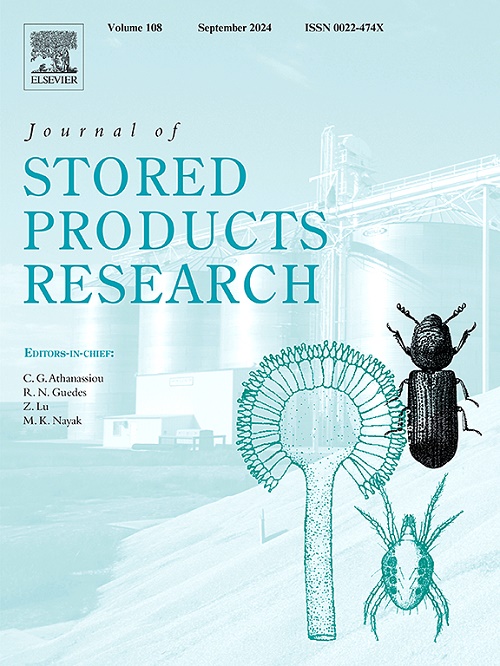电子鼻在农业粮食有害生物检测、鉴定和监测中的应用综述
IF 2.7
2区 农林科学
Q1 ENTOMOLOGY
引用次数: 0
摘要
生物害虫的袭击和侵染是储粮损失的主要原因,导致重大的粮食和经济损失。传统的、手工的、基于采样的害虫识别方法是劳动密集型的、耗时的、昂贵的、需要专业知识的,甚至可能无法检测到隐藏的虫害。近年来,电子鼻(e-nose)方法已成为农业粮食害虫识别和监测的潜在替代方案。电子鼻通过集成传感器阵列、数据采集和分析,模拟人类嗅觉系统,通过分析粮食和害虫释放的挥发性有机化合物(VOCs)来识别粮食害虫。然而,缺乏关于使用电子鼻技术检测粮食害虫的充分记录,策划和综合文献。因此,本文系统地综述了目前最先进的电子鼻技术在农业粮食有害生物监测中的应用。综述了采用的传感器技术、目标害虫种类类型、颗粒介质、数据处理和模式识别技术。电子鼻是一种很有前途的工具,它提供了一种快速、非破坏性的解决方案,用于检测、识别和监测粮食害虫,包括微观和隐藏的昆虫,具有很高的准确性。我们确定了影响电子鼻性能的因素,包括害虫种类、储存时间、温度、湿度和害虫密度。主要的挑战包括传感器阵列的优化或选择,大数据处理,可重复性差,以及测量之间的可比性。廉价和便携的电子鼻有可能帮助利益攸关方和存储管理人员及时采取数据驱动的知情行动或决策,以减少总体粮食和经济损失。本文章由计算机程序翻译,如有差异,请以英文原文为准。
Electronic nose for agricultural grain pest detection, identification, and monitoring: A review
Biotic pest attacks and infestations are major causes of stored grain losses, leading to significant food and economic losses. Conventional, manual, sampling-based pest recognition methods are labor-intensive, time-consuming, costly, require expertise, and may not even detect hidden infestations. In recent years, the electronic nose (e-nose) approach has emerged as a potential alternative for agricultural grain pest recognition and monitoring. An e-nose mimics human olfactory systems by integrating a sensor array, data acquisition, and analysis for recognizing grain pests by analyzing volatile organic compounds (VOCs) emitted by grain and pests. However, well-documented, curated, and synthesized literature on the use of e-nose technology for grain pest detection is lacking. Therefore, this systematic literature review provides a comprehensive overview of the current state-of-the-art e-nose technology for agricultural grain pest monitoring. The review examines employed sensor technology, targeted pest species type, grain medium, data processing, and pattern recognition techniques. An e-nose is a promising tool that offers a rapid, non-destructive solution for detecting, identifying, and monitoring grain pests, including microscopic and hidden insects, with good accuracy. We identified the factors that influence the e-nose performance, which include pest species, storage duration, temperature, moisture content, and pest density. The major challenges include sensor array optimization or selection, large data processing, poor repeatability, and comparability among measurements. An inexpensive and portable e-nose has the potential to help stakeholders and storage managers make timely and data-driven informed actions or decisions to reduce overall food and economic losses.
求助全文
通过发布文献求助,成功后即可免费获取论文全文。
去求助
来源期刊
CiteScore
5.70
自引率
18.50%
发文量
112
审稿时长
45 days
期刊介绍:
The Journal of Stored Products Research provides an international medium for the publication of both reviews and original results from laboratory and field studies on the preservation and safety of stored products, notably food stocks, covering storage-related problems from the producer through the supply chain to the consumer. Stored products are characterised by having relatively low moisture content and include raw and semi-processed foods, animal feedstuffs, and a range of other durable items, including materials such as clothing or museum artefacts.

 求助内容:
求助内容: 应助结果提醒方式:
应助结果提醒方式:


